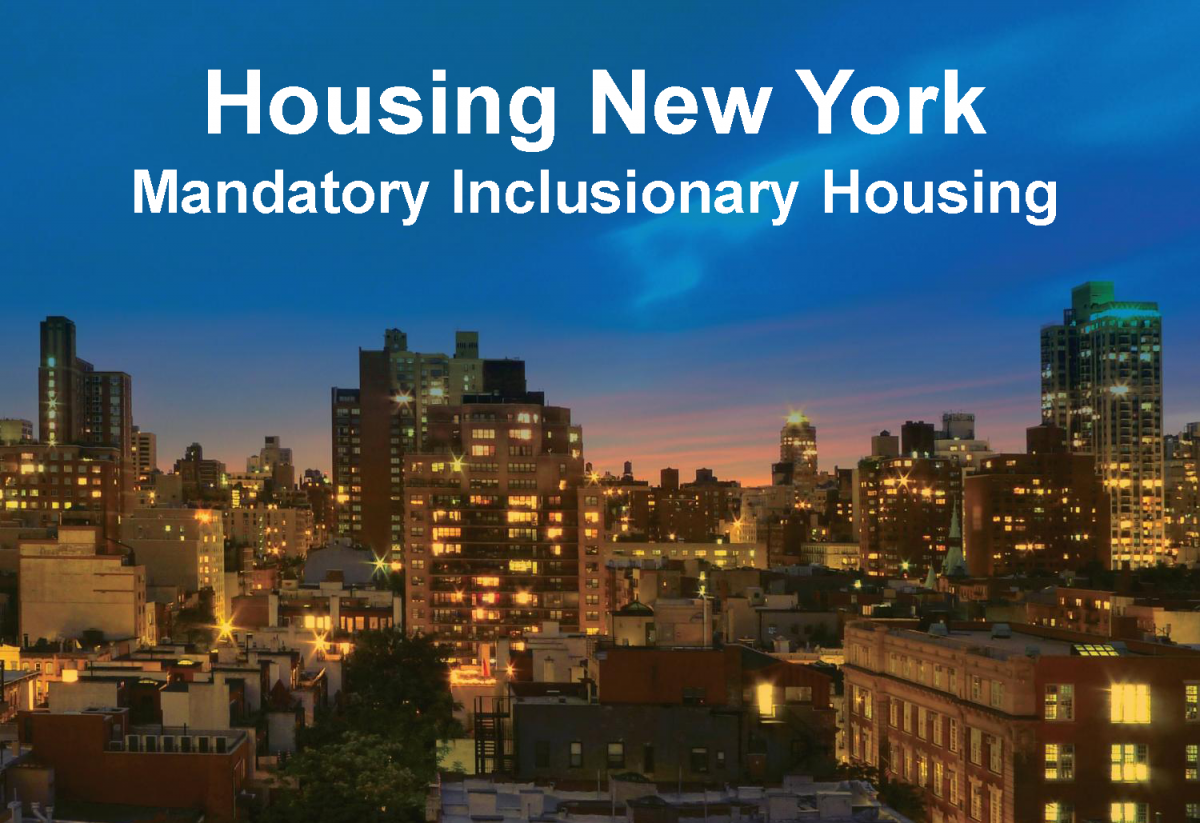Overview of NYC’s Existing Inclusionary Housing Programs
The purpose of NYC’s existing Inclusionary Housing Program (IHP) is to encourage the creation and preservation of affordable housing in New York City. These programs promote affordable housing within IHP designated areas, R10 districts outside of IHP designated areas, and Mandatory Inclusionary Housing (MIH) designated areas. Inclusionary housing in IHP districts and R10 districts is voluntary, but incentivized. Inclusionary housing in MIH districts is mandatory and permanent.
According to the Department of City Planning, IHP was established to promote the creation and preservation of housing for residents with varied incomes, and to enhance neighborhood economic diversity. This program gives floor area bonuses to buildings that create affordable housing in IHP Designated Areas (as mapped in Appendix F of the Zoning Resolution) or in R10 zoning districts outside of IHP Designated Areas. The R10 portion of this program was created in 1987, and expanded on in 2005 with the launch of IHP “Designated Areas”.
In 2016—to further the Mayor’s goal for creating and preserving 200,000 affordable homes in 10 years—the Department of City Planning created the MIH program, which is the strongest affordable housing program in any major city in the United States. However, as explained in pages 4 and 5 of the City Planning Commission Report on MIH, the MIH regulations will have no effect until specific MIH areas are designated; currently there are no MIH Designated Areas, but they will be created when areas are rezoned in a way that would significantly increase local housing capacity.
OVERVIEW OF MIH ZONING TEXT CHANGES
According to the new MIH regulations, affordable housing must be provided for residential developments, enlargements, or conversions within MIH areas. Alternatively, the developer may choose to make a payment to an affordable housing fund instead of creating affordable units if the development creates between 11 and 25 units. Affordable units are not required for new residential developments, enlargements, or conversions that are less than 12,500 square feet and would create fewer than 10 residential units.
Highlights from the MIH Program Include:
Greater FAR Allowances
A higher FAR is permitted for MIH developments as a way of providing space to accommodate affordable housing. The amount of additional permitted FAR varies by zoning district, as well as by the amount of affordable housing provided on each lot.
Amount of Required Affordable Housing
In MIH areas, developers must provide affordable housing—or, in some cases, may contribute to the Department of Housing Preservation and Development (HPD) Inclusionary Housing Fund instead. When affordable housing is provided, there are four permitted options: Option 1, Option 2, the Deep Affordability Option, or the Workforce Option. The City Planning Commission and City Council will decide which option is applicable in each MIH designated area. The Workforce option will not be permitted in the Manhattan Core.
- Option 1: 25% of the Residential floor area must be affordable, with varying levels of affordability that average to 60% of the income index*.
- Option 2: 30% of the Residential floor area must be affordable, with varying levels of affordability that average to 80% of the income index.
- Deep Affordability Option: 20% of the Residential floor area must be affordable, with varying levels of affordability that average to 40% of the income index.
- Workforce Option: 30% of the Residential floor area must be affordable, with varying levels of affordability that average to 115% of the income index.
Affordable Housing Fund Option: If the number of dwelling units in a development is increased by 11-25 units, the developer can make an annual contribution to an affordable housing fund instead of providing affordable housing. HPD will determine the monetary amount that is the equivalent of adding new affordable housing floor area.
Location of Affordable Units
Regulations regarding the location of affordable units were adopted to prevent a “poor door” situation where residents of affordable housing live in lower quality, or stigmatized housing that is noticeably separated by income.
The locations of affordable units must comply with the following regulations:
- Affordable units shall be distributed on at least 65% of the residential stories and the MIH units must share a common street entrance with the market-rate units.
- Affordable housing can be provided on a separate zoning lot if the developer provides additional affordable housing that is the equivalent of 5% of the residential floor area within the MIH development, multiplied by the percentage of the affordable floor area that is provided off-site. That separate lot must be within .5 miles of the development or within the same Community District.
When MIH units are on the same lot as market-rate units, but are in a separate building, MIH dwelling units may either share a common street entrance with the rest of the dwelling units on the lot, or it may have a separate entrance if that entrance is on a street that has primary entrances for other residential buildings.
Exception: The entrance can be on a street that doesn’t have primary entrances for other residential buildings if HPD determines that the primary entrance does not stigmatize occupants of the affordable housing units.
Bulk Regulations
Alternative bulk regulations apply to affordable housing developments as a way to provide a FAR bonus and ensure quality development of buildings with affordable units. The applicable bulk regulations for MIH developments vary based on zoning district, as detailed in the text.
Special Permits
MIH requirements can be modified by a Board of Standards and Appeals (BSA) special permit if there is a hardship. This BSA application will lapse and require reconsideration every four years.
Additionally, where City Planning Commission (CPC) approval is needed for projects that will significantly increase residential floor area, the Commission may require that development comply with MIH regulations even if that project is not in an MIH area.
*Income Index: 200% of the Very Low-Income Limit established by the Department of Housing and Urban Development (HUD).
For any additional questions or comments on this topic, please contact Milrose Consultants. To stay informed on the latest zoning changes impacting the real estate development industry, subscribe to our free monthly newsletter.
See also: New York City Proposes Mandatory Inclusionary Housing, NYC Zoning Code Turns 100








